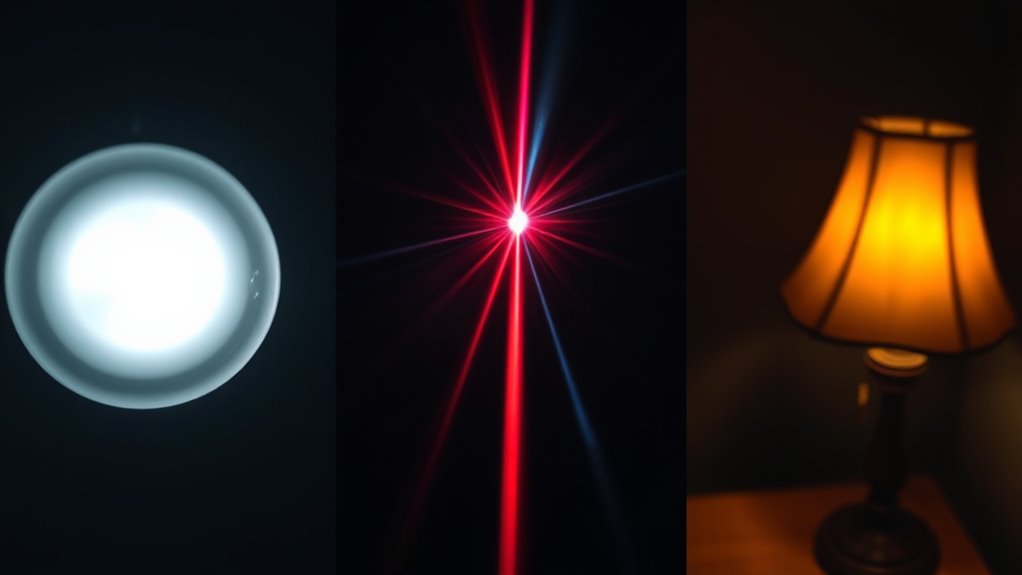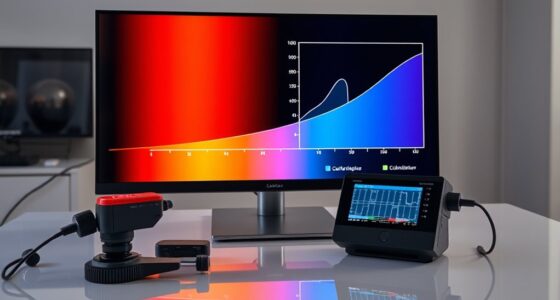LED, laser, and lamp lights produce colors through different emission methods. LEDs generate light by electron recombination, offering broad spectra but limited purity. Lasers emit highly monochromatic, coherent light, providing vivid, saturated colors with top accuracy. Traditional lamps produce soft, diffuse light across a wide spectrum but with less vibrancy. Understanding these differences helps you choose the right type for your needs—stick around to explore how each technology impacts color quality and application.
Key Takeaways
- LEDs emit broad-spectrum light with limited spectral purity, affecting color vibrancy and accuracy.
- Lasers produce highly monochromatic, narrow-spectrum light, resulting in vivid, saturated, and true-to-life colors.
- Traditional lamps emit diffuse, broad-spectrum light with lower color precision and softer visual effects.
- Laser light maintains consistent color stability over time, unlike LEDs and lamps which may fade or shift.
- The spectral characteristics influence applications: lasers for color accuracy, LEDs for energy efficiency, lamps for ambient illumination.
Understanding the Basic Principles of Light Emission
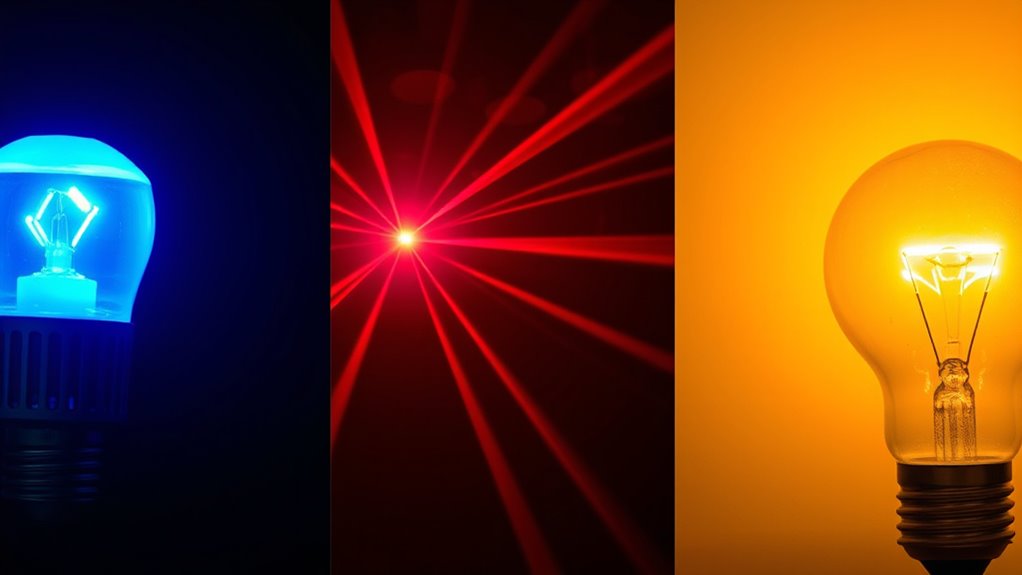
Understanding how light is emitted is fundamental to grasping the differences between LED, laser, and lamp light sources. At the core of this process is photon emission, where atoms release energy in the form of photons. In LEDs, electrons recombine within a semiconductor, producing a specific light spectrum characteristic of the material. Lasers generate photon emission through stimulated emission, resulting in highly coherent and monochromatic light. Traditional lamps produce light by heating a filament or gas, emitting a broad light spectrum. Each method determines how the light spectrum appears, influencing color quality and intensity. The spectral output of each source plays a crucial role in applications requiring precise color rendering and brightness. Recognizing these basic principles helps you understand the fundamental distinctions in how each source creates light, setting the stage for exploring their unique characteristics.
Key Characteristics and Color Quality of Each Technology
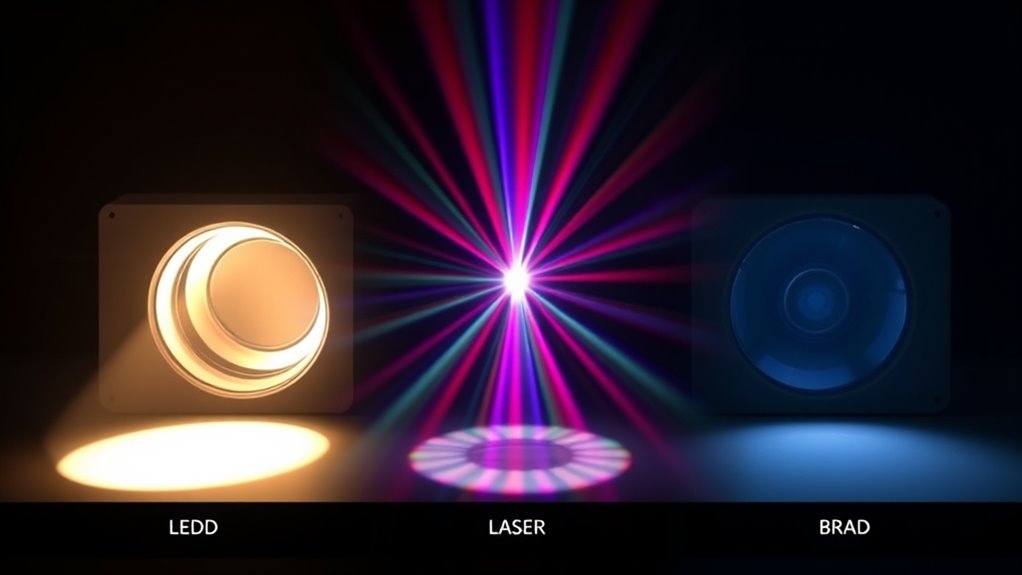
You’ll notice that each technology offers different levels of brightness and color range, affecting how vivid your images appear. Color accuracy and consistency also vary, influencing the fidelity of the displayed colors. Understanding these key characteristics helps you choose the right technology for your specific needs. Additionally, color fidelity is impacted by the underlying display technology, which determines how accurately colors are reproduced on the screen.
Color Brightness and Range
When comparing LED, laser, and lamp lighting technologies, their brightness and color range are key factors that influence their visual impact. LEDs typically offer high brightness with a broad color spectrum, but their spectral purity can be limited, affecting the vibrancy of colors. Lasers excel in spectral purity, producing highly saturated colors with intense brightness, and their narrow beam divergence allows for concentrated, powerful illumination over long distances. Lamps, while providing softer, more diffuse light, usually have a wider spectral range but lower overall brightness and less intense color saturation. The combination of high spectral purity in lasers and controlled beam divergence results in vivid, bright visuals, whereas LEDs and lamps prioritize a broader color range and softer output. Personalized in-home care emphasizes tailored solutions that can also incorporate innovative lighting options to improve comfort and well-being.
Color Accuracy and Consistency
Among the three technologies, laser lighting delivers the highest color accuracy and consistency due to its narrow spectral output, which produces precise and vibrant colors with minimal variation. This spectral purity guarantees that colors are true-to-life and accurately represented, making lasers ideal for applications requiring precise color reproduction. Additionally, laser systems maintain excellent color stability over time, reducing shifts or fading that can occur with other light sources. In contrast, LEDs and lamps often have broader spectral outputs, leading to less accurate color rendering and potential color shifts with age. As a result, laser technology offers superior control over color quality, ensuring consistent, true colors in your displays or projections. This consistency is essential for professional settings where color precision directly impacts visual quality.
Energy Efficiency and Power Consumption Considerations
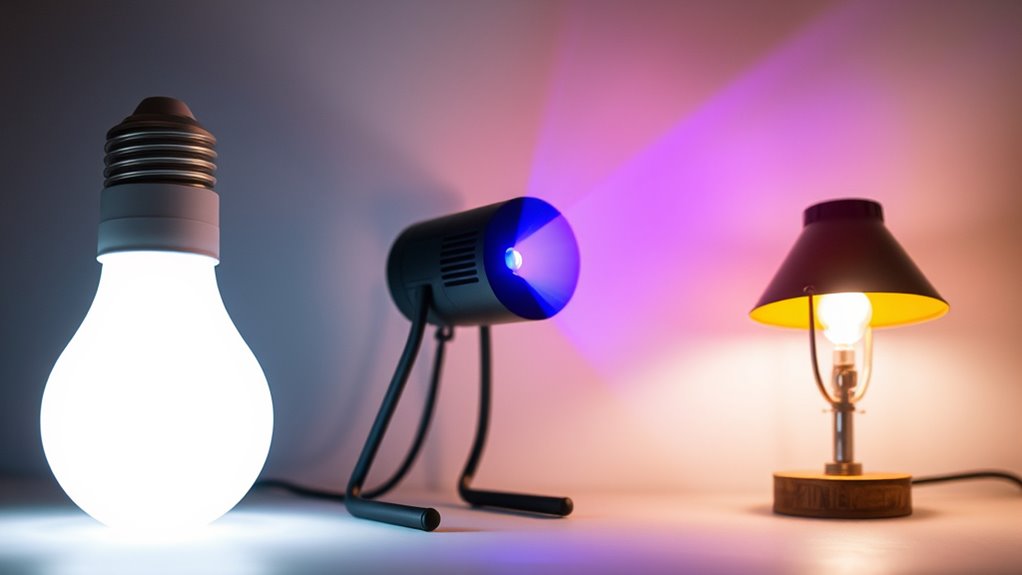
LED, laser, and lamp light sources differ markedly in their energy efficiency and power consumption. LEDs are highly energy-efficient, offering considerable energy savings because they convert most electricity into visible light with minimal waste. Lasers also tend to be efficient, especially in applications where focused, intense light is needed, but they often require more power to operate at high intensities. Traditional lamps, like incandescent or halogen bulbs, consume much more energy for the same brightness, leading to higher electricity costs. If you’re aiming for better energy savings and improved power efficiency, LEDs are generally the best choice. They use less power, produce less heat, and deliver consistent brightness over time. Additionally, understanding energy efficiency can help you make more sustainable lighting choices that reduce overall environmental impact. Choosing the right light source can greatly reduce your overall energy consumption.
Applications and Fields of Use for LED, Laser, and Lamp Light
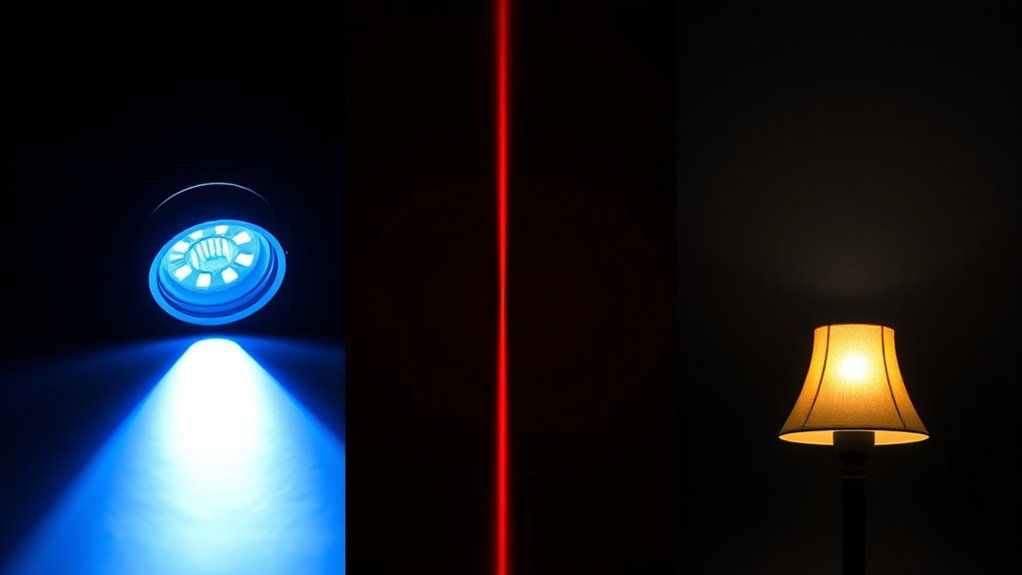
LED, laser, and lamp lights serve a wide range of applications across different fields. You’ll find them in medical procedures, scientific experiments, industrial processes, and everyday consumer devices. Understanding their specific uses helps you appreciate how each light type enhances various technologies. For example, light source technology greatly influences the effectiveness and precision of these lighting solutions in their respective applications.
Medical and Scientific Uses
Because of their unique properties, LED, laser, and lamp light sources play essential roles in medical and scientific fields, enabling precise diagnostics, treatments, and research. Historical advancements have revolutionized procedures like laser eye surgery and phototherapy, while cultural perceptions influence acceptance of new technologies. You might imagine a surgeon guiding a laser beam to correct vision or scientists using LED light to observe cellular behavior. These technologies allow for targeted therapies, minimal invasiveness, and detailed imaging. They’re used in dermatology, cancer treatments, and diagnostic instruments. LED and laser lights help visualize tissues or activate drugs, pushing scientific boundaries. Their versatility and precision make them indispensable in advancing medicine and research, transforming how we diagnose and treat conditions today. Additionally, innovations in light source technology continue to expand the possibilities for scientific exploration and medical applications.
Industrial and Consumer Applications
Industrial and consumer applications of LED, laser, and lamp lighting have become integral to everyday life, offering practical solutions across various fields. In industrial settings, high spectral purity from LEDs and lasers improves quality control, inspection, and precise measurements, while effective thermal management guarantees device longevity. Consumers benefit from LED lighting in homes and electronics, where energy efficiency and color accuracy enhance visual comfort. Laser technology finds use in barcode scanners, printers, and entertainment devices, leveraging their focused, intense light for accuracy and performance. Lamps, with their broad spectrum, provide general illumination. Across all fields, understanding spectral purity helps optimize color rendering, while thermal management prevents overheating, ensuring reliability and safety in both industrial and consumer applications. Additionally, advancements in hydrogen fuel cell technologies emphasize the importance of thermal management to maintain system safety and efficiency.
Advantages and Limitations of Each Lighting Method

Each lighting method offers unique advantages and faces certain limitations that can influence your choice depending on your needs. LED lights excel in energy efficiency and long lifespan, but may have limited color saturation compared to lasers. Laser lighting provides intense, precise beams ideal for high-accuracy applications, though they can be costly and require careful handling. Traditional lamps often deliver warm, broad illumination at a lower initial cost but lack the color consistency and longevity of LEDs or lasers. Additionally, advancements in AI safety and security, such as ongoing monitoring and development of safety measures, are crucial to address vulnerabilities and ensure trustworthy deployment. AI security remains an important consideration in the development and application of lighting technologies, especially as they become more integrated with smart systems. Visualize sharp, focused beams cutting through darkness with laser precision. Picture warm, diffuse light filling a cozy room effortlessly. Your decision hinges on balancing color saturation, cost considerations, and application-specific needs.
Factors to Consider When Choosing the Right Lighting Solution

for instance, laser lights excel in high-intensity displays, while lamps may suit ambient lighting. Budget constraints also matter, as initial costs vary. Ultimately, balancing color quality, longevity, application purpose, and cost helps you select the best lighting solution for your space.
Frequently Asked Questions
How Do Environmental Factors Affect LED, Laser, and Lamp Light Performance?
Environmental factors profoundly impact LED, laser, and lamp light performance. Light pollution from nearby sources can cause glare and reduce visibility, especially at night. Weather conditions like rain, fog, or dust can scatter or absorb light, diminishing brightness and clarity. Additionally, environmental impacts such as temperature fluctuations can affect the longevity and efficiency of these light sources, making it essential to evaluate surroundings for ideal performance and minimal light pollution.
What Maintenance Is Required for Each Lighting Technology Over Time?
You need to regularly check your LED lights for signs of dimming or flickering, as their longevity can be affected by heat and electrical issues. For lamp-based systems, you’ll need to replace the lamp bulb when it dims or burns out. Laser projectors require minimal maintenance, but keeping lenses clean and ensuring proper cooling is essential to maintain peak performance over time.
Are There Health Concerns Associated With Laser or LED Light Exposure?
Like a cautious hiker avoiding sharp rocks, you should be aware of health risks with laser or LED light exposure. Laser lights can pose eye hazards if directly viewed, and prolonged LED exposure might cause eye strain or discomfort. Follow safety precautions like wearing protective eyewear and avoiding direct exposure to intense light sources. Staying mindful helps you enjoy the benefits while keeping your eyes safe from potential harm.
How Do Color Rendering Indexes Compare Among LED, Laser, and Lamp Lights?
You’ll find that LED lights typically offer high color rendering indexes, ensuring accurate color perception and vibrant visuals. Laser lights often excel in precise, sharp color rendering, making them ideal for detailed visual tasks. Traditional lamp lights may have lower indexes, leading to less accurate color representation. Overall, LEDs tend to provide better color accuracy and enhance your visual perception, especially in settings where true-to-life colors matter most.
Can These Lighting Methods Be Integrated With Smart Home Systems?
Imagine installing LED, laser, or lamp lighting that seamlessly syncs with your smart home system. You can easily control brightness, color, and schedules through automation compatibility features. These lighting methods are highly compatible with smart home integration, allowing you to set scenes or adjust lighting remotely. Many modern smart bulbs and fixtures support popular platforms like Alexa, Google Home, or Apple HomeKit, making your lighting smarter and more convenient.
Conclusion
Choosing the right lighting depends on your needs, whether it’s energy efficiency, precision, or ambiance. LEDs, lasers, and lamps each have their strengths and limitations, so weigh your options carefully. Remember, “the right tool for the right job” saves time, money, and frustration. By understanding these technologies, you’ll make smarter decisions and light up your world effectively. Ultimately, informed choices lead to brighter, better outcomes.
